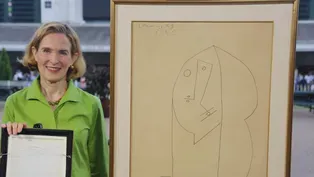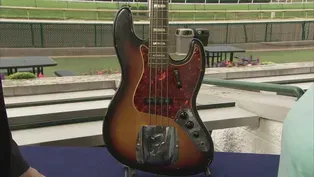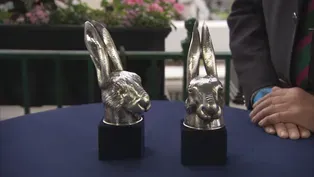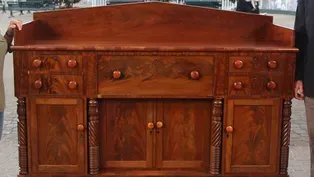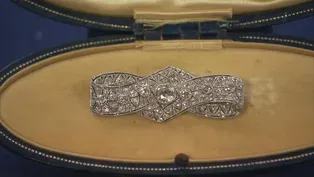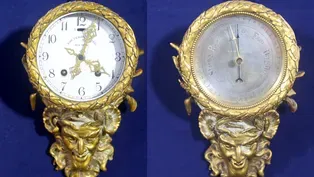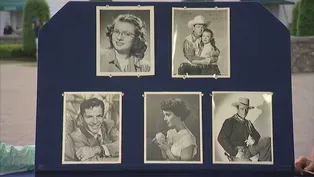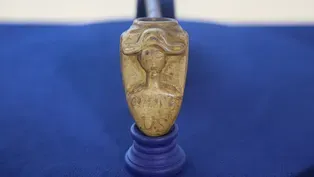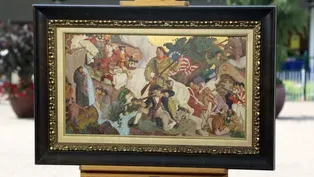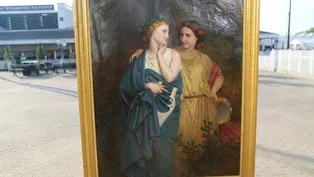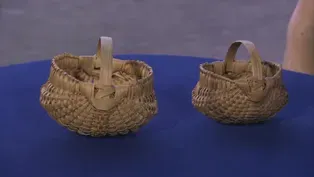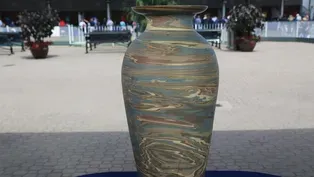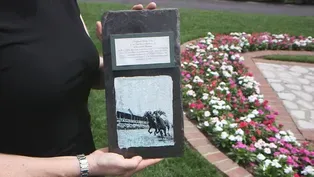

Churchill Downs Racetrack, Hour 1
Season 23 Episode 13 | 52m 29sVideo has Closed Captions
It’s off to the races for amazing appraisals at Churchill Downs Racetrack!
It’s off to the races for amazing ANTIQUES ROADSHOW appraisals at Churchill Downs Racetrack like a Twin Spires painted roof slate from around 1895, a 1943 Picasso ink-on-paper and 1963 letter, and an art deco brooch. One may be worth up to $200,000!
Problems with Closed Captions? Closed Captioning Feedback
Problems with Closed Captions? Closed Captioning Feedback
Funding for ANTIQUES ROADSHOW is provided by Ancestry and American Cruise Lines. Additional funding is provided by public television viewers.

Churchill Downs Racetrack, Hour 1
Season 23 Episode 13 | 52m 29sVideo has Closed Captions
It’s off to the races for amazing ANTIQUES ROADSHOW appraisals at Churchill Downs Racetrack like a Twin Spires painted roof slate from around 1895, a 1943 Picasso ink-on-paper and 1963 letter, and an art deco brooch. One may be worth up to $200,000!
Problems with Closed Captions? Closed Captioning Feedback
How to Watch Antiques Roadshow
Antiques Roadshow is available to stream on pbs.org and the free PBS App, available on iPhone, Apple TV, Android TV, Android smartphones, Amazon Fire TV, Amazon Fire Tablet, Roku, Samsung Smart TV, and Vizio.
Buy Now

ANTIQUES ROADSHOW 2025 Tour!
Enter now for a chance to win free tickets to ANTIQUES ROADSHOW's 2025 Tour! Plus, see which cities we're headed to!Providing Support for PBS.org
Learn Moreabout PBS online sponsorshipMARK WALBERG: "Antiques Roadshow" is off to the races at Churchill Downs Racetrack in Louisville, Kentucky.
MAN: It's kind of cool, because it's signed, and it's also dedicated to my grandfather.
But it's actually "U.S. Grant"... No way!
...misspelled.
♪ ♪ WALBERG: This is Churchill Downs, home of the most exciting two minutes in sports, the Kentucky Derby.
(starting bell ringing) Some of the greatest thoroughbreds in America, perhaps even in the world, have given their all on the Churchill Downs Racetrack: Secretariat, War Admiral, Citation, Seattle Slew, Sir Barton-- just to name a few.
Churchill Downs began as the business venture of Colonel Meriwether Lewis Clark back in the 1870s.
Clark wanted to replicate the spectacle of horse racing that he had witnessed in England.
And with the help of his uncles John and Henry Churchill, Clark began what is now one of the most important racetracks in thoroughbred racing.
What are the chances "Roadshow" will find incredible art and antiques here today?
Well, let's just say, the odds are very good.
♪ ♪ Oh, it is Italian.
It's Italian!
Yes, it is.
Well, that's a big surprise.
It is so Italian.
It's made by a very, very important firm called Barovier.
That's what it says on the bottom.
Oh, okay.
See, it says...
I can see what's left of it.
Uh-huh.
The "Barovier" and the "Murano."
MAN: Well, this is a little tea set that my mom, she's 94 years old, she's had it, like, 50 years.
We don't know a whole lot about it, but it's always been a treasured item of mine.
Okay.
So what's wonderful about this, it's actually Mexican.
Oh.
And the tops are turquoise.
So it's really a lovely little miniature silver tea set.
They do come up for auction-- I've seen several examples.
And if I were to see this come up for auction today, I'd expect an estimate of about $500 to $700.
Wow, she'd love to hear that.
Well, hey, thanks for coming in today.
Okay, thank you.
All right, thank you.
What did you bring me?
Well, they're two silver hare's head stirrup cups.
If you pick them up and hold them by the ears, as it were, they are a cup-- you can drink out of them.
They were designed to be passed around at a hunt meet and allow the mounted followers to have a, a bit of brandy or port before the hounds moved off.
That looks like a pretty big shot to take just before you go out.
I suspect they were designed to be passed from person to person and not, not a single-person dose.
I think they'd be falling off the horse.
I think so.
I would have been.
(laughing) They're both made by Tiffany and Company, and one of these has a Tiffany and Company mark here.
They both actually have the "T. and Co." mark, but the other marks, right here, you have a date letter, and the other mark that you have here is a leopard's head.
And that's the city mark for London.
So here we have a date, we have the city of London.
And this lion here is probably the most important mark, which says that it's the sterling standard.
So it's something that you would find on all English cups of this size.
And it's interesting, I went in search of these models.
The date for one is 1983, and another one is 1988.
So they're quite recent.
Yes.
But it's interesting to note that, that I found a Wedgwood and Bentley pair of black basalt cups that are identical that were from 1780.
Interesting.
So it's that "everything old is new again" sort of thing.
(laughs): Yes.
Any idea of what they might be worth?
No-- I mean, I remember what I paid for them... Uh-huh.
but I have no...
I paid $1,400 for that one, and $1,200 for this one.
I think you did well, because in today's market, for insurance, I would insure these at $9,000 for the pair.
Okay.
Thank you.
They are so cute.
(laughs) You almost want to bite their heads off, if they weren't just heads anyway.
That's right.
Yeah.
WALBERG: The Churchill Downs Racetrack, first known as the Louisville Jockey Club, has held thoroughbred racing, the Kentucky Derby, and the Kentucky Oaks since 1875.
This is an oil sketch, or a rough draft, if you will, done by artist Dean Cornwell.
It depicts the characters that he was pitching to my grandfather, the architect, for a set of murals in the Tennessee State Office Building in Nashville in the late '30s, early '40s.
And it's kind of cool, because it's signed, and it's also dedicated to my grandfather.
So tell me a little bit more about how they knew each other.
Well, in 1937, my grandfather had also hired Dean Cornwell for another building in Nashville.
It was the Davidson County Courthouse.
And then, a few years later, when Grandfather got the Tennessee State Office Building project, Dean Cornwell made a return appearance for another set of murals.
And he ended up giving the rough draft, the oil sketch, to my grandfather.
Okay, and have you been able to figure out who any of these characters in the painting might be?
This sketch, it's kind of hard to tell.
But in the two final versions that are hanging in the office building, there are some keys or some legends that actually depict who is Daniel Boone or Andrew Jackson or John Sevier, who was our first state governor.
These are kind of nondescript, but it gave you an idea of what he was thinking when he was going to do the murals.
Mm-hmm, yeah.
So Dean Cornwell is a fairly well-known American illustrator, and he was actually born right here in Louisville, Kentucky.
He did go to Chicago for school at the Art Institute, and then the Art Students League in New York.
But this was his hometown, so it's really special to see this piece here.
I didn't know that.
He was hired to do these two murals, which are now in the actual John Sevier State Building.
That's in Nashville, Tennessee.
What I find really interesting about this is that it is a preliminary oil painting for the two much larger murals that he ended up realizing.
It combines elements from both of those, which is really kind of neat to see, how he may have used this painting to pitch the idea to your grandfather, or whoever else was making the decisions, and just say, "This is kind of what I'm thinking.
This is the way I want to go with this."
And out of that were born these two murals that still exist today.
It's really special, because, as you can imagine, those murals are permanently affixed to that building, and they will continue to stay there.
People can go see them, but that's really the only access that the public has to a painting like this.
You can't purchase it.
It cannot be bought at auction or in a gallery.
It's a public artwork.
The painting is oil on board, and we even have a bit of gold pigment in the upper sky area, which mimics the final mural.
We do have a signature and a date in the lower center.
His name, Dean Cornwell, and he always stacked his name that way, where you have "Dean" on the top and then "Corn" followed by "Well," and the date of 1942, which is probably not when it was painted but when it was given to him.
Now, do you have any idea of the value?
Have you had the painting appraised?
I inherited this from my grandmother, probably 1984, and we thought it would be a good idea to get it appraised then for insurance purposes.
And I can't remember what the figure was.
I think it was somewhere, plus-or-minus around $10,000, maybe?
If we were going to estimate this painting for auction today, the estimate would be $25,000 to $45,000.
Wow, amazing.
I would not insure this for any less than $90,000.
Mmm.
My goodness.
90!
(laughing) Wow, that's incredible.
Wow.
I think my sister is going to not speak to me after this.
(laughing) ♪ ♪ It looks like it's in great shape.
I mean...
I was hoping initially it was "D.E.
Vecht."
But I think that's very clearly an A and then a D. APPRAISER: The signature is here, but you will almost certainly never find the artist.
Okay.
Because it's not a recorded artist.
Okay.
It's just an amateur person who happened to be good at painting.
Nice thing.
WOMAN: This is comic art that I received for a wedding gift 30 years ago from my cousin Meg, and it was done by my uncle, her father, John Cullen Murphy.
That's great.
And the history behind it is, Hal Foster created the "Prince Valiant" strip in 1937, continued on until about 1970, when he felt it was time to slow down a little bit.
And it's a real honor, I would think, for the family, to have your uncle chosen as the person to replace one of the greatest comic artists in history, to take over doing the strip.
For the first few years, early on, Foster would send over kind of roughed-out or drawn-out pieces, and then Murphy would finish them up.
Mm-hmm.
And then Murphy took over the strip later on, himself.
Mm-hmm.
This is right at the beginning, this is 1971.
Even the fact that Foster really didn't do this himself, I would probably put an auction estimate somewhere between $2,000 and $4,000.
Mm-hmm.
And then, as the strips got later and later on, they do kind of decrease in value.
Because the storyline changed a little bit, and Foster was totally out of it.
Mm-hmm.
But it's just a great, great piece of artwork, and I'm thrilled that you brought it today.
Lucky to have it.
Yeah.
I'm from Memphis, and we went to an estate sale several years ago.
And the house had been in the same family for... ever since the Civil War.
And the gentleman that owned the house was a Civil War doctor.
It has a name on it, "Grent."
So we did a little research and think maybe he was from the Andersonville war camp from the Civil War.
So my husband and I wondered, "How in the world "did a pipe from maybe Andersonville camp end up in Memphis, Tennessee?"
I think maybe the doctor treated him and maybe traded the pipe for payment.
That's just a guess, but I don't know.
And did you get a good deal on it?
No, paid a lot of money, I think, for it.
What did you pay?
$600.
But it was a gift for my husband.
He loves things to do with the Civil War.
Anything old.
So it was a splurge.
Well, when you set that thing down on the table, I guess you could tell that I was interested.
It gave me a little pitter-patter.
This pipe was, is carved out of limestone.
Okay.
And there just happened to be a lot of it around, out in Illinois and St. Louis.
Okay.
And there were two Union prisons there.
And there was this group of Confederate carvers who were prisoners there who developed amazing skills carving these pipes.
No way.
In the last five years, there's probably been 20 or 30 pretty amazing pipes carved by Confederate prisoners.
And all of them have the images of Jeff Davis or the Palmetto Tree or the Confederate flag and things like that.
This pipe was likely carved by a Confederate prisoner of war for a can of peaches or a bag of tobacco.
Why would somebody fighting for the South carve something like this?
And I wanted to show the front to start with.
It's got this guy on there with this weird hat, which you don't think about being from the Civil War.
And, you know, you think the name is "Grent," but it's actually "U.S. Grant"... No way!
...misspelled.
It's U.S. Grant.
No way!
That's a picture of Ulysses Grant, and on the side, he puts American flags.
He puts the Union flag on both sides.
(laughing) I guarantee you that was carved by a Confederate prisoner, and he carved it in exchange for some favor from one of his jailers.
Wow.
It's a rare survivor, and I wanted to put it like this.
Look, he made that side of it like a shoe.
That's so... Did you ever notice that?
I have not noticed that, but you're right.
I'm so excited, I can't wait.
So you thought you paid a lot at $600?
I did, I have to admit.
Well, we think you got a pretty good deal.
And I think a conservative auction estimate would be $3,000 to $5,000.
Yes!
(laughing) Oh, I'm very excited by that.
That's fabulous-- I can't believe that.
I hope...
Think that'll make your husband happy, too?
Yes, he's going to be sad he didn't come with me, absolutely.
(laughs) Oh, that's awesome.
Fantastic, thank you so much.
Thank you for bringing it in.
My pleasure.
Made my day.
It was my bucket list.
I'm so excited to be here.
APPRAISER: What you have here is a wonderful record player from the late '30s, and it's an RCA Victor Special.
And it's just a wonderful, streamlined design.
You've got bright red colors on the inside, the nice polished aluminum.
Very desirable, very collectible piece.
I have no problem putting the insurance at $2,500, $3,500 on it.
WOMAN: Is that what you brought to the Antiques Roadshow?
Yeah.
He just comes along with us for the ride.
What's his name?
Cow Cow.
Aw.
WOMAN: I found them in my mother's attic when we were cleaning it out to get ready for an estate sale.
Mm-hmm, mm-hmm.
So... Why didn't you put them in the estate sale?
Because I liked them.
Okay, okay.
What... what was... what about them did you like?
I just think they're cute.
They're, they look like they're in really good shape.
I have no idea.
I don't know anything about them.
Figured they'd been in the family for a while.
Well, they're little miniature melon baskets.
And the fact that you said they're cute is what makes them so compelling... Mm-hmm.
...because indeed they are.
They're made of oak, and what's lovely about these two little ones is that they also have some dyed oak in them.
These are decorated with these wonderful stripes, and the bright yellow is probably created either from sumac or actually onion peels.
It's a natural dye.
And then the brown is walnut shells.
I don't know if you've ever been picking walnuts.
Mm-hmm.
It gets your fingers all brown.
Yeah.
So it...
It's just a little decorative element.
These are difficult baskets to date.
They could have been made as late as the Depression.
I mean, they were making these baskets... Mm-hmm.
...all through the early 20th century.
Yes.
And families did them, it was almost a cottage industry.
Mm-hmm.
People did it to supplement their incomes.
Do you have any idea of their value today?
I have no idea.
I think if I, I found them in an antique shop, I would expect to pay maybe $200, $300 apiece for them.
Oh, really?
Yeah.
Yeah.
Wow.
Somebody else is going to wish they had went into my mother's attic before I did, I guess.
♪ ♪ WALBERG: The racetrack consists of 147 acres and features a one-mile dirt oval racetrack, plus a seven-furlong turf race course.
What's a furlong?
Well, it's an eighth of a mile, or 220 yards.
MAN: These are a weathervane and a clock that my grandparents had.
They worked in upstate New York at a lodge.
When they retired, these are one of the things that they gave them for retirement.
They've been passed down through our family.
My mother had them, now I have them.
They've been hanging on the wall for years, and it was, like, we were getting ready to remodel.
And we said, "Well, these have got to go."
So we actually put them on the floor under the bed and had them under the bed for years.
And a friend of mine told me about the Antique Roadshow, so we made plans to come.
And we got tickets to come down here.
And so we brought them to see exactly what they're worth and where they came from.
They're very heavy, and we just had them for years.
They look kind of wild, like the devil or something, you know, in these pictures?
(laughs): Yeah.
Well, you have two very unusual... Well, actually, it makes it a clock set, a clock, and this is actually a barometer.
Right.
To have a clock and a barometer as a sort of a pair is really unusual.
Typically, people just bought a clock and would hang that on the wall.
This probably was designed to go either, on either side of a window or a door.
Okay.
And you said they were very heavy.
I would agree with you.
Their castings are super-heavy.
They probably weigh five, six, seven pounds apiece.
To have a case like that quality is something that is evident or, or certainly obvious when you look at them.
You'll notice that they have two different dials.
Mm-hmm.
Barometers typically have a silver dial, and it's engraved.
It's a brass dial, that has a silver wash over it, and the black hand is a contrast against that.
The other dial is actually enamel, and it shows up very nicely.
If you notice how nicely the hands are detailed...
Yes.
They're really quite wonderful.
And it has a name on both of them, so we know that they were made both for the same retailer: Caldwell Company in New York.
All right.
Really quite incredible.
These both were probably made about 1890.
Wow.
Actually, even 1880.
Quite early for this type of thing.
Fantastic quality.
I consulted with a couple of colleagues here today, and we were in agreement.
If you polish them up or clean them up a little bit, and you put them in a higher-end retail store, certainly reasonable to expect to get somewhere in the neighborhood of $4,500 for the pair.
Wow!
(chuckles) Not bad for having something under your bed.
Not at all, yes, indeed.
Yeah.
I would say that before it was in the mounting, it was probably used a lot, because...
Okay.
...the edges have been wiped off a little bit... Uh-huh.
So it was probably handled, so therefore not in mint or very fresh condition.
With the bezel, it's really just worth the jewelry value.
So let's go ahead and weigh it, and I'll get you a value on it.
Okay, that'll be fun.
I bought this in Memphis at a small auction about seven years ago.
Uh-huh, and...
Paid $130 for it.
Okay.
I thought it was pretty, so that's why I bought it.
It's really sweet, it's wonderful.
And, of course, it's Ben Franklin, immediately recognizable as him.
A couple of my colleagues have said, yes, they think it is 18th-century, and a couple of my colleagues have said that, "We really think it's probably a centennial."
But it's certainly no later than the 1870s.
WOMAN: Well, this is my mother.
In the picture, she was 19.
APPRAISER: Wow.
But two years later, she had me, and she was diagnosed with polio.
And she was in the hospital for six years in an iron lung.
Wow.
So your entire childhood, she was incapacitated.
Exactly.
And so how did she come to have all these photographs?
Well, Roy Rogers and Dale Evans were doing a benefit or a show in Kokomo, and they went and visited her in the hospital.
And they asked if there was anything they could do for her, and she said, "I'm 25, I'd like movie star pictures."
So when they got back to Los Angeles, they sent her 37 movie star pictures autographed to her.
It's a pretty remarkable statement about Roy Rogers and Dale Evans.
Do you remember them, or...?
I do.
Yeah?
Because, at one of the benefits in Kokomo, my dad took me so I could pet Trigger and see Roy and Dale.
And I sat on Trigger.
So they were pretty important to me.
And now they're more important.
So they were obviously extraordinary people and great humanitarians.
Yes, they were.
Well, they had that reputation in Hollywood, and, quite honestly, I think that's one of the reasons their show was such a juggernaut and so popular, because people really felt like they knew them, because they really were the gracious, warm people that you saw on TV.
And the fact that they went to such great efforts and heard about your mom's story and did this is extraordinary.
We know that the provenance on these is solid, and they're all signed to your mother.
They're all personalized, "To Mary Jo."
And it's a pretty extraordinary assortment.
You have 37 total, we're showing just four here.
And one of the greatest things is, we have dates on these.
We know they were all signed around 1951 when they were gathering the autographs.
And to have a precise date, at the point in their careers, every one of these people was at the height of their popularity.
Do you have a favorite?
Well, yes, Roy Rogers and Dale Evans.
Well, you'd be interested to know that of all the ones on this board, that's actually the least valuable.
(gasps): You're kidding.
If we were to go through individually on these... Mm-hmm.
...this would be the least expensive of the grouping here, because they were such generous people.
They actually really signed a lot of photos.
Oh, I see.
And they were very generous about doing it.
You can find these anywhere between $50 to $75.
Really?
Mm-hmm.
Elizabeth Taylor also was generous.
It's nice to have a glamorous shot of her, but, from this era, it's $75 to $100.
Hmm.
And then Sinatra from that period, on a picture like that, is $1,000 to $1,500 at auction.
Oh, my goodness.
And the John Wayne is $1,500 to $2,000.
So most of your value in the entire collection is in those two photos.
Is that... oh, my goodness.
But the memories are all in this one for you, for sure.
Oh, well, and this one.
Of course.
Yeah, mm-hmm.
Thank you so much.
MAN: Brought a painting that used to belong to my mother.
And she purchased it at an auction and gave it to my wife and I about 20 years ago.
It's a painting, we believe, by Elizabeth Jane Gardner, who my mother was somewhat familiar with, having purchased a painting painted by the same artist before.
And she recognized this painting when it came up for auction, and purchased it, and ultimately gave it to us.
And when did she purchase it, approximately?
I think it was 1994.
And where did she purchase it?
At a New York auction.
She bid on the telephone and purchased it.
For how much?
I believe she paid $14,500 for it.
She had told me the original estimate was $2,000 to $3,000, but she recognized the artist and thought that it had a lot more value and decided to bid higher, and... and she purchased the painting.
This is Elizabeth Jane Gardner Bouguereau, and she was known as the wife of William Bouguereau, who was one of the most famous and influential 19th-century French academic and realist painters.
The composition itself is a copy of one of his compositions.
His original painting is in the Musée du Château de Fontainebleau in France.
Her relationship to William Bouguereau is, is an interesting story, actually.
She was an American.
She came to Paris to study art.
And she was not really allowed to study at a lot of the important art schools like the École des Beaux-Arts.
So she had to resort to certain tricks, like dressing like a man, to be able to attend draftsmanship classes.
She was a consistent exhibitor at the Paris salons.
She was especially well-known for the milky, porcelain-like skin.
Now, the painting is not signed, but there may be a reason that it's not signed.
She was sometimes criticized for copying Bouguereau.
There's a quote by her that, where she said, "I'd rather be known as an imitator of Bouguereau than be known for nothing."
The painting is oil on canvas, it's not dated, however, the original was painted by William Bouguereau in 1861.
She became a student of his in 1877.
She studied with him for about 17 years, until about 1896, when she finally married him.
And they were waiting to get married because his mother wouldn't allow it, and they waited until his mother passed away.
My best guess is that it would be... have been painted between 1873 and 1896.
Your mother bought it in 1994, you said.
Yes, yes.
What do you think it's worth today?
I really don't know.
I would hope that it's appreciated in value.
And we've had it hanging in our dining room for the last 20 years.
In general, a lot of 19th-century paintings have, have gone down in value over the past ten to 15 years, because there's been a tendency towards contemporary.
One of the exceptions is William Bouguereau, and another one of the exceptions is his wife.
They are considered really some of the best of 19th-century painting.
In certain sales, recently, they've done considerably better than in the 1990s.
I think at auction, a conservative auction estimate would be $50,000 to $70,000.
Very good.
That... that sounds very good.
Thank you!
Well, I don't think it's soft-clay stoneware.
It could be, but I've not seen it look like this.
It looks like a heart, is what it looks like.
So I just think we have another classic '60s to early '70s hippie pot.
APPRAISER: Some of it has actually been hand-colored.
So, I think somebody took a lithograph and hand-colored it.
And it's a pretty excellent image.
And I say that because we see so many of these decorative prints that come through here, but often they're not very exciting.
But this one has some great sort of mythological allegory.
WOMAN: Well, it was my grandmother's pin, given to my mother.
And then, my mother gave it to me.
Sad to say, I don't know where my grandmother got it, if her husband gave it to her for an important birthday or anniversary, or a gift from her father.
I have no idea.
She gave it to me at age 94.
She said she wasn't wearing it that much, so she said I could have it.
My mother was... said my grandmother was always so sweet and let her wear her jewelry.
And she wore it when she was in college.
She went to a dance and had it on and lost the pin at the dance.
I don't know if she was doing the Charleston or what, but she lost it.
And then, her Aunt Florence was there, and she went to her and said, "I've lost the pin."
She goes, "What?
You've lost your grandmother's diamond pin?!"
Anyway, so... No more jewelry for you!
Yeah, yeah, but anyway, they found it at the dance.
Thank heavens.
(laughs) Well, it's so beautiful, and it, it really struck me when I first saw it.
It's such a nice example of a strong Art Deco piece.
It's a brooch, and it is all pierced platinum and diamonds.
The center diamond is an old European-cut diamond, and it weighs just over one carat.
It's a nice, white, lively stone, and it really grounds the design overall, which is all hand-done.
It's not signed, unfortunately.
Mm-hmm.
I hoped to find a signature on it.
But it is in its original box from Myron Freeman and Brothers, who was a jeweler out of Atlanta at the time, which would have been around about 1930.
Mm-hmm.
Overall, there's about four-and-a-half carats in the brooch, including the center stone.
And at auction today, I would give it a conservative estimate somewhere in the neighborhood of $6,500 to $8,500.
Wow.
That's nice to know, although, as I said, I have no intention of selling it, because I, I love the family history with it.
Yes.
♪ ♪ WALBERG: Sitting atop the grandstand are the twin spires.
Designed by architect Joseph Dominic Baldez, the spires were part of the new grandstand constructed in 1895.
The twin spires have become the iconic architectural symbol of Churchill Downs.
♪ ♪ WOMAN: I brought in a slate that was taken down from the twin spires.
I found it at a yard sale, somebody didn't want it.
I paid two dollars for it.
Two dollars?
Yeah, so, I live here in Louisville, and it's a little piece of history.
It hangs in my kitchen, so people usually do comment on it, just kind of ask me about it.
And I just know that, what it says on the plaque there.
Well, two bucks is a lot better than climbing the roof to try to pull it off.
Yes, it is.
And obviously, someone took some artistic license here.
Yeah.
And I think it's fantastic.
Yeah, fantastic.
But with the limited research I've done, I'd still put an estimate of $200 to $400.
That's amazing-- that's awesome!
Oh, that's wonderful, thank you.
See?
This is your winning ticket!
It is, thank you, yeah.
And a lot, a lot safer bet, for sure.
(laughs) Thank you.
♪ ♪ WOMAN: My parents bought it in 1975.
They remodeled after the tornado in 1974, and so they needed a piece.
And apparently Daddy found it at an antique shop down in Lebanon, Kentucky.
I understand that he paid $500 for it.
A friend of my parents, she thought that was way too high for the piece, so...
Okay, so were they... That's all I know.
Were they collectors?
My aunt had been an antique dealer, and they just liked different pieces.
But Daddy found it when he was down in the area on business.
What did the antique shop tell them when they bought it?
All I know is, it says it's from the 1800s.
It was made by an old Quaker cabinetmaker named George Wiley.
I have not been able to find any information out about it.
Hmm.
But it is the sideboard that has that middle drawer, opens up, and it's a desk, like a butler's desk, so...
Right, they sometimes did put a butler's desk in these, and this one does have that.
And you, you just pull it open and drop the front down.
And instead of a sideboard, you have a wonderful writing desk, where...
Yes, I love that about it.
It's got some really exciting figured mahogany veneers.
You notice how it's, it's in a very sort of flat plane.
How did they date the piece?
Did they say?
They said 1800s.
It didn't say if it was early or late.
Okay.
My suspicion, it's a little later, because...
I'm hoping maybe you can tell me about this carve.
Okay.
Well, you're exactly right.
It is a little bit later.
And if it was 1800, it would probably have inlay in it.
And as we get to the 1820s, the sort of classicism, the taste for these plainer veneers without inlay, is coming into focus a little bit.
The peaked pediment on this kind of recalls the Parthenon, and that sort of, like, urge for that pure classicism is what we start to see in this period.
20 years earlier, a sideboard like this would have probably had long, skinny legs.
Ah.
So, as you get into this, 1820s or so, I would say this is probably about 1825.
Okay.
One of the, the tricks with that is that, historically, a lot of the, the academic research that's gone into these has focused on a slightly earlier period, and it makes identifying the exact origin of these a little bit trickier.
And the piece does give me some clues in the, the kind of woods the cabinetmaker used.
It has poplar and white pine secondary.
I think it probably is a Kentucky sideboard.
Oh, cool.
And especially given its retrieval history and where it came from.
But they were making very similar sideboards in Virginia, and in Tennessee, and in a lot of sort of surrounding areas.
So we're, we're in a little bit of a, a gray area here, as far as it doesn't have those inlays that we can sort of ascribe to certain areas and things like that.
And I'm not familiar with George Wiley, but I'm very interested in the Quaker element there.
I would love to know more about what the dealer who sold this knew about that.
I will say that, like, in the 18th century, Quaker cabinetmakers, they wanted to use solid woods that were very high-quality, but the idea of putting a veneer on was sort of a little disingenuous.
But it could have been a Quaker, but I wonder if that wasn't just sort of a... just an embellishment.
It's carefully handmade.
It is top-quality woods.
I think the Kentucky attribution will hold up, but it needs a little more sussing out.
So if you walked into an antique shop today, would you buy this sideboard?
I don't know.
I like the size and the height of it.
I tend to go with the longer legs.
Yeah.
But I do like it.
Yeah.
It's a family piece, you know.
Well, and I think that's... That's exactly what the rest of the market thinks, too.
Uh-huh.
And I think, from a collector's perspective, they'd love to see those tall, slender legs...
Yes.
...on this.
And as we get into this later period... Uh-huh.
...and the heavier forms... Uh-huh.
...we do tend to see demand sort of drop off.
Yeah.
What do you think it's worth?
I'm guessing... $3,000.
I could definitely see it priced that way in a shop.
I think, on the auction block... Uh-huh.
...it would, it would bring less.
Yeah.
It's probably more like a $1,000 to $2,000 piece.
Yeah, uh-huh.
But think about the value that you get for that.
Yeah.
I think time will bear it out.
It does make good tornado shelter.
(laughs) You can always, like, get in the, in the cabinet.
This is a very... as we carried this out here, it's a very solid piece of furniture.
♪ ♪ This came from western Virginia.
I bought it in 1968, for two bucks apiece.
Tell me again how you feel about this painting.
Oh, I love it, it's hanging on the wall.
Okay, and why do you love it?
The kittens.
Okay.
APPRAISER: Loving it and having a discussion about value are two different things.
WOMAN: I bought it at a garage sale for two dollars.
My dad gave it to me.
He was in Vietnam, and he bought that in Hong Kong and sent it back home.
And then he started playing, opening shows for people like George Jones and Tammy Wynette.
And he played for 30 years, so...
It does fit into that time frame.
This is a 1968 Fender Jazz Bass.
Hong Kong is probably one of the more unusual places to buy one.
It was made in California.
Oh!
During the Vietnam time, a lot of goods ended up over there for the soldiers that were on R and R. Okay.
This model was introduced in 1960.
Nice.
The original bass from Fender, in 1951, was called a Precision Bass.
But jazz players wanted more of a trebly, brighter sound and a little bit faster action, and this Jazz Bass model was, was invented.
It's got a very narrow nut and a faster neck, and it's become a very popular bass over time.
They still make this same model today, and they've made thousands of them over the years.
This guitar is in the standard sunburst finish.
Okay.
And it's in... Oh, I'd call it very good-plus condition, all original.
Yes.
Do you have any idea of what he paid for it when he bought it?
Oh, he told me $90.
$90?
Yes.
He was tickled when they told him, "$90."
(chuckling) Yeah, that's very cool.
That, that's a very good price.
You'd like to buy a lot of them for $90 now.
(laughs) In today's market, at retail, this guitar would sell for between $4,500 and $5,000.
My goodness.
He will be thrilled.
Oh, great.
It's got kind of that smoky finish from playing in bars.
Yeah, there was a lot of bar playing going on.
(laughing) But I like that.
MAN: It's a, a doll bed that's a Murphy bed.
So it's... it looks like a cabinet, but opens up and turns into a little bed for a doll.
APPRAISER: And where did you get it?
From my father's estate home in Boston that they lived in for four generations.
So we don't know...
In Boston, that's very interesting.
Don't know how far back it went.
Well, it is really a, really a complicated little device.
And I want to show you how it works.
We open these doors, and we have a blanket area, storage.
We close this, we have a place for a washbasin.
And of course, we open here and we have a little mirror, and I guess you could stand and shave.
But the magic happens when you open it like this... And what do we have here?
We have a Murphy bed, complete with... Mattress, and fully functional.
APPRAISER: Another curious feature is that each side has these little drawers, which, I've no idea what they're for, but it certainly adds a feature.
This also has a little... would have had a shelf here, for some purpose.
Obviously, that's missing.
You said this was a doll bed.
Well, there's some question about that, and I've been discussing it with some of my friends to really figure it out.
In many ways, you could consider it a salesman sample.
Oh.
Because it displays so many things.
It seems a little odd thing to create as a doll bed.
And it has a maker's name right here.
William Kelly, Bath, Maine, patented April 19, 1870, which is pretty early for a doll bed, I think.
I think those things together, the patent date is that early, would suggest more of a functional model of a, of a real thing, which is what a salesman sample would be.
Now, I love salesman samples.
And that's what intrigues me about this.
And in fact, as I say, because it has so many complex items, this is a perfect thing for a salesman to carry around.
As far as salesman samples are concerned, the ones that are really desirable are the ones that have metal and complex functioning aspects.
When you get into brown furniture salesman samples, it's not quite as much.
But, you know, as a sample...
I would think at auction, this could easily bring $2,000.
(laughing) Never seen it.
It could be the only survivor.
APPRAISER: It's a wonderful decorative item.
I thought this would be a fun piece.
He thought it be nice in the basement or at Goodwill.
French, in the later part of the 19th century, were masters at casting his base.
APPRAISER: I love it.
I actually collect this stuff myself.
This particular period, I think it's tremendously overlooked.
And as a result, it's affordable.
It's a really wonderful piece.
I'm not quite sure who she is.
♪ ♪ APPRAISER: What was the thought process in bringing this in today?
MAN: Well, I wanted to get something that caught everybody's attention, and it has.
(laughs) The parking lot was lit up when we came.
We got it from a friend of ours who was cleaning house and moving to Florida.
She used to work at a department store in St Louis.
Okay.
And she got it from, I guess, the model shop or somebody, a friend of hers that worked there.
And I figure it's, you know, it was a display somewhere in the store, and given the look of it, from several, you know, pretty many years ago, '50s or '60s.
Sure, sure.
Yeah, that definitely would be the time period, 1950s, 1960s.
Looks like it's some kind of cast resin.
If you look under the paint, it's definitely not wood.
So display, exactly.
I mean, who knows for what?
Certainly not gloves.
But scarves, possibly jewelry, belts, anything that would hang on this.
Oh, belts.
Maybe even hang a coat on there.
So, and here's the thing-- the value in this is the look.
It's really cool.
It's, it's a great conversation piece.
Go find another one, right?
Right.
So you know, we have to think about that in terms of how we value it.
I think in a decent antiques show, a dealer could ask as much as $300 to $500 for it.
Wow, great, great.
Yeah.
I think it's pretty awesome, and just as a conversation thing.
And even if you bought it to put your own clothes on and display, it's got so many uses and it's got a great look.
So...
I'm psyched.
Yeah, we decorate it for Christmas, we do all kinds of things.
♪ ♪ WALBERG: One horse is buried at Churchill Downs Racetrack: Barbaro, the winner of the 2006 Kentucky Derby.
ANNOUNCER: And it is all Barbaro, in a sublime performance!
He runs away from them all, and he has saved something left for the Preakness.
Barbaro wins by seven!
WALBERG: Two weeks after winning the derby, Barbaro suffered an injury that ultimately led to his being euthanized in January 2007.
Barbaro's fans can visit his final resting place without paying an admission fee at the garden outside the main entrance into the racetrack.
♪ ♪ This is part of my grandfather's collection.
It was in one of his rooms that he had at the house and he always had American flags in it.
Where was your grandfather from?
From Nebraska.
I think it's Arkansas clay.
You had asked someone about it once.
You asked a museum one time to tell you about the piece.
And what did they tell you?
Well, they said that they didn't make one this big.
Well, you know it's Niloak.
And it was made in Benton, Arkansas.
The company was run by the Hyten family, Charles Hyten.
And around 1912, Mr. Hyten started making these pieces with, probably, Arkansas clay.
Mmm.
And the idea was to get different-color clay and throw them together to get this swirl effect.
Mm-hmm.
And it's become known as missionware.
Oh, uh-huh.
And it works very nicely with mission furniture-- with a lot of decor.
Oh, wow.
We're going to tip this over.
Here's the Niloak mark right here.
It's N-I-L-O-A-K. Do you have any idea where the name Niloak comes from?
No.
It's actually "Kaolin" spelled backwards.
Now, kaolin is the main ingredient in porcelain.
Oh.
Now, this is not porcelain.
This is earthenware, it's made out of native clays, but that's where the name comes from.
And Niloak started making pieces of missionware around 1912... 1912.
...and probably made them until the 1940s.
So it's difficult to tell exactly when this was made, but somewhere in that time frame.
What's really impressive about this piece is the size.
And I would think that the man who threw this literally had to be a very hefty, strong man.
There's a lot of clay in this piece.
Where I have seen pieces like this, it's typically a sand jar.
And a lot of times, they would be used in the front of a Masonic temple, where you would have sand in it to put cigarettes out.
Oh, uh-huh.
So they were oftentimes made in pairs.
But there aren't many of these.
Even though the market for American art pottery is pretty soft right now, this is an exception, because it's so big.
Uh-huh.
I believe, in an auction setting, that we're probably looking at this piece selling for between $5,000 and $7,000.
My goodness, I'd have never expected that.
♪ ♪ This is a screw-and-plate set from DePuy, and that these are medical things that my father had.
My mother was stationed in Japan right after the war.
Mm-hmm.
And she collected several items.
And this is one of them.
I like the lace look on it.
It's very nice, the scrollwork, yeah.
This dates from the late 19th, early 20th century, so probably about 1880 to about 1910.
So in the middle of the Meiji period.
Okay.
But a pretty object.
Thank you.
Now, those were made by my great-grandfather, who was a major in the Civil War and became a doctor afterwards.
I don't know what their significance is, other than they're Bakelite, and, an early plastic.
A very... the very first plastic, as far as I know.
And that's why I dragged you over here.
Because they're not Bakelite.
Ah!
You, you were barking up the right tree.
Okay.
But it's called gutta-percha.
And what that is, it's the sap, the resin, from a tree.
Ah.
So this is gutta-percha.
It was very typical.
These classic sweetheart rings-- people in the service, the same way, you know, you see, like, from World War II, sweetheart jewelry, victory jewelry, things like that.
I mean, you see the two hearts, you know, the hand pointing to one of the hearts.
This plaque here probably would have been meant to have somebody's initial put on it.
WOMAN: Oh, okay.
Oh.
Yeah, it's really cool, and if, if you saw the Bakelite and you kind of looped it, you'd see the difference in the texture and the sheen and the porosity.
You would see it right away.
You'll, you'll never forget it.
So this is a clump that you'll find oozing from a tree, that gets hard, and you just shape to whatever you want.
You can shape it, you can actually warm it and mold it.
Ah, so this is temperature-sensitive.
Yes, yeah.
Okay.
Not going to melt in your hands here, though.
(laughs) Okay.
It's not terribly valuable.
$50 to $100 per ring.
Very nice.
♪ ♪ WALBERG: Secretariat, owned by Penny Chenery, was the first horse to win the Triple Crown in 25 years when he won in 1973.
This extraordinary horse did what no others had done before when he ran each of the five consecutive quarter-miles faster than the one before.
My grandmother was a great aficionado of Picasso, and she loved him, and she felt she really understood him, and she often would go to New York, to auction houses.
And she bought this in the early 1960s from her reputable auction house there.
And it's signed, "Picasso," and she felt that it was a Picasso, but she wanted to be sure.
So she took it to a reputable gallery and asked the owner of the gallery what she thought.
And she said, "I'm going to Paris.
"Let me take a photograph of it to Picasso, and we'll find out."
So on the other side of the inscription is the photograph.
The photograph of this was presented to Picasso, and he wrote on the back of it, "This sketch..." or, "This is indeed mine," signed it, "Picasso," and it says, "The 25th of October 1963."
That's great.
So we in the business get excited about great ownership history, or great provenance, for a work.
And it's an ink-on-paper, and it's a very rapid sketch.
Signed in the upper left, "2nd of March 1943, Picasso."
And your note over here next to it does appear to be in Picasso's script, and that is essentially supposed to be him authenticating the work.
Right.
So we wade into these matters often as it relates to authentication.
Hm.
And you've given us some great clues.
We're in the field.
So you're here at the Antiques Roadshow, and appraisers might have a great feeling about a work.
Mm-hmm.
And they might feel very strongly about it, as we do here.
But, ultimately, we cannot authenticate it for a certainty today.
Mm-hmm.
I will tell you that today, we feel very strongly that there is a excellent chance that this work is correct, that it would get that blessing by the experts.
It's a wonderful example of this period, a quick sketch with African influence and abstraction.
And, assuming that the work is correct, it would be a very desirable example.
So... Let's assume that it's correct.
Have you ever wondered at its value?
Um, yes, and I have to say that we love it so much, that that's... you know, it really represents my grandmother to us.
I actually think of it as being my grandmother, a sketch of our grandmother-- of course, it isn't.
Yes, the monetary value is important, but the emotional value is really incomparable.
So let's assume that, that our collective sixth sense among my colleagues and I is correct, and that we're right, and it got that blessing.
If that were the case, a reasonable, fair-market auction value today would be $100,000 to $150,000.
Whoa.
Okay, I don't think we were anywhere in that range.
(chuckling) (laughs) That's incredible.
An insurance value for the work would fall in the range of $200,000.
Okay.
Having this inscription by the artist, who essentially would have reviewed it roughly 20 years later and acknowledged the fact that it was in his hand...
Right.
...absolutely is a part of that package.
Right.
It adds to its ownership history and provenance.
Right.
If the work is deemed to be inauthentic or, or a copy of some kind, its value would be largely decorative and would fall in the range of $500 to $700 for a faithful copy.
Right.
But nowhere near what it would be if it were correct.
Right, of course.
WALBERG: You're watching "Antiques Roadshow" WALBERG: And now it's time for the Roadshow Feedback Booth.
And the ring was supposed to be... real, but it's a made ring.
It's still worth about $300, although I got $400 in it.
(laughing) And this painting print from Fountain Square in Cincinnati, by Don Kingman, was only worth $100.
But we had a lot of fun.
(laughing) And I have this pin, that was my great-great-grandmother's.
To me, it's priceless.
To anybody else, it's worth a hill of beans.
We came today with a picture.
My husband thinks it's worth a lot of money.
He's going to be sad to find out it's not.
So they said it wasn't a work of art, but "Antiques Roadshow," you still have my heart.
And I have good and bad news on my item.
I brought a piece of old ivory that was my great-grandmother's.
It's from the 19th century.
The bad news is, it broke when I first came here.
But the good news, it's not worth that much, so I didn't lose that much except for the value to me.
But I'm going to make a birdbath out of it.
And I brought the "Trapp Family Singers" book.
♪ Do, my book's not worth much dough ♪ And this Hans Namuth photograph is a ray of golden sun worth between $700 and $1,000.
So long.
Farewell.
Thanks, "Antiques Roadshow."
WALBERG: I'm Mark Walberg.
Thanks for watching.
See you next time on "Antiques Roadshow."
Appraisal: 1943 Picasso Ink-on-Paper & 1963 Letter
Video has Closed Captions
Clip: S23 Ep13 | 3m 52s | Appraisal: 1943 Picasso Ink-on-Paper & 1963 Letter (3m 52s)
Appraisal: 1968 Fender Jazz Bass
Video has Closed Captions
Clip: S23 Ep13 | 1m 55s | Appraisal: 1968 Fender Jazz Bass (1m 55s)
Appraisal: 1971 John Cullen Murphy "Prince Valiant" Art
Video has Closed Captions
Clip: S23 Ep13 | 1m 17s | Appraisal: 1971 John Cullen Murphy "Prince Valiant" Original Art (1m 17s)
Appraisal: 1983 & 1988 Tiffany & Co. English Stirrup Cups
Video has Closed Captions
Clip: S23 Ep13 | 2m 9s | Appraisal: 1983 & 1988 Tiffany & Co. English Stirrup Cups (2m 9s)
Appraisal: American Classical Sideboard, ca. 1825
Video has Closed Captions
Clip: S23 Ep13 | 4m 33s | Appraisal: American Classical Sideboard, ca. 1825 (4m 33s)
Appraisal: Art Deco Diamond & Platinum Brooch, ca. 1930
Video has Closed Captions
Clip: S23 Ep13 | 1m 57s | Appraisal: Art Deco Diamond & Platinum Brooch, ca. 1930 (1m 57s)
Appraisal: Caldwell & Co. Clock & Barometer Set, ca. 1885
Video has Closed Captions
Clip: S23 Ep13 | 2m 31s | Appraisal: Caldwell & Co. Clock & Barometer Set, ca. 1885 (2m 31s)
Appraisal: Celebrity-signed Photos, ca. 1951
Video has Closed Captions
Clip: S23 Ep13 | 3m 1s | Appraisal: Celebrity-signed Photos, ca. 1951 (3m 1s)
Appraisal: Confederate Prisoner-carved Pipe
Video has Closed Captions
Clip: S23 Ep13 | 3m 39s | Appraisal: Confederate Prisoner-carved Pipe (3m 39s)
Appraisal: Dean Cornwell Mural Study, ca. 1941
Video has Closed Captions
Clip: S23 Ep13 | 3m 47s | Appraisal: Dean Cornwell Mural Study, ca. 1941 (3m 47s)
Appraisal: Elizabeth Jane Gardner Bouguereau Oil, ca. 1880
Video has Closed Captions
Clip: S23 Ep13 | 3m 32s | Appraisal: Elizabeth Jane Gardner Bouguereau Oil, ca. 1880 (3m 32s)
Appraisal: Miniature Dyed-oak Melon Baskets, ca. 1920
Video has Closed Captions
Clip: S23 Ep13 | 1m 42s | Appraisal: Miniature Dyed-oak Melon Baskets, ca. 1920 (1m 42s)
Appraisal: Niloak Missionware Vase, ca. 1925
Video has Closed Captions
Clip: S23 Ep13 | 2m 50s | Appraisal: Niloak Missionware Vase, ca. 1925 (2m 50s)
Appraisal: Salesman's Sample Bed, ca. 1870
Video has Closed Captions
Clip: S23 Ep13 | 2m 49s | Appraisal: Salesman's Sample Bed, ca. 1870 (2m 49s)
Appraisal: Twin Spires Painted Roof Slate, ca. 1895
Video has Closed Captions
Clip: S23 Ep13 | 46s | Appraisal: Twin Spires Painted Roof Slate, ca. 1895 (46s)
Providing Support for PBS.org
Learn Moreabout PBS online sponsorshipSupport for PBS provided by:
Funding for ANTIQUES ROADSHOW is provided by Ancestry and American Cruise Lines. Additional funding is provided by public television viewers.


